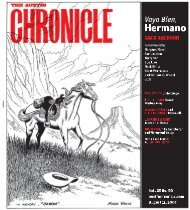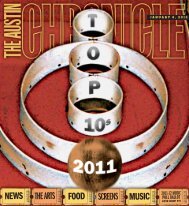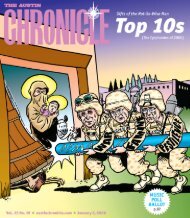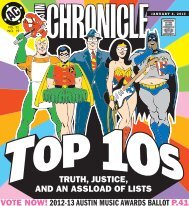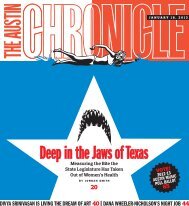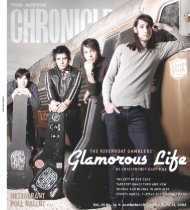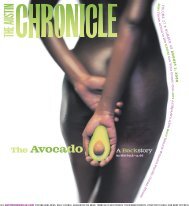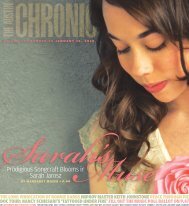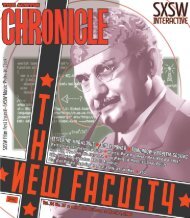You also want an ePaper? Increase the reach of your titles
YUMPU automatically turns print PDFs into web optimized ePapers that Google loves.
THE ARTSTHEATREClassics ComebackAre the great dramas of yore reclaiming their place on<strong>Austin</strong>’s stages?BY ROBERT FAIRESEuripides, is that you?You’ve been away so long, I almost didn’trecognize you. And who’s that behind you?Mikhail Bulgakov? Never thought to see himaround these parts again. And J.B. Priestley,how long has it been? And is that EugeneO’Neill, too? And Sartre? And Molière? AndSheridan, Coward, and Chekhov?Seems like every time you turn around thissummer, you bump into another Grand OldGeezer of Western Drama somewhere on the<strong>Austin</strong> theatre scene. As the mercury is risingto record heights, so too is the number oflocal productions of plays that, for lack of abetter term, could be called classics – roughlydouble the number that were mounted fromMay through August of 2008. In fact, for thefirst time in at least a generation, the numberof classics onstage looks to be outpacing thenumber of new plays being produced locally.That’s a fairly stunning turnaround for thiscommunity, rather like having oatmeal suddenlydisplace migas as <strong>Austin</strong>’s breakfast fareof choice. To the extent that <strong>Austin</strong> is knownfor theatre, it’s known for new plays. <strong>The</strong> cityhas been fertile ground for original dramas, Isuspect, since Col. Zilker started making ice,if not before – with the occasional local playeven garnering some recognition beyondour city limits (e.g., the counterculturemusical/happeningStomp, akaNow the Revolution,which caught theeye of Joe Pappand playedNew YorkLEAH SHARPEand Europe in the Seventies). But once threehomegrown plays, in fairly quick succession,found notable success inside and outside <strong>Austin</strong>,a real surge in new play production began. <strong>The</strong>trifecta of Gertrude Stein Gertrude Stein GertrudeStein, by Marty Martin; Greater Tuna, by JoeSears, Jaston Williams, and Ed Howard; and Inthe West, by the company members of Big StateProductions, proved that there was an audiencefor <strong>Austin</strong>-generated plays, both locally andnationally, and anyone who wasn’t already anaspiring screenwriter sat down to the keyboardand began tap-tap-tapping out a script for thestage. Which companies then responded to byproducing them, sometimes in new play developmentprograms, sometimes through festivalssuch as FronteraFest, where playwrights couldmount their work. And the UT Departmentof <strong>The</strong>atre & Dance began beefing up its playwritingprogram and production of studentgeneratedmaterial. Up sprouted more andmore new companies that focused on mountingoriginal material: the Rude Mechanicals,Loaded Gun <strong>The</strong>ory, Rubber Repertory, andYellow Tape Construction Company, to name afew. And more and more works coming out ofthose companies made their way to appreciativeaudiences around the country: the RudeMechs’ Lipstick Traces and Get Your War On,Dan Dietz’s tempOdyssey, Steven Tomlinson’sAmerican Fiesta, John Walch’s <strong>The</strong> DinosaurWithin, et al. By the late Nineties, the area hadenough playwrights that an organization, <strong>Austin</strong>Script Works, was founded to support theiractivities. Over the past 25 years, new playshave gone from representing about one-fifthof the theatrical work produced in the <strong>Austin</strong>/Georgetown/San Marcos area to just about onethird– a fact that has been noted with wonderin theatrical circles across the land. This cityloves its new plays.<strong>The</strong> classics, not so much. Back in theday, the golden oldies of the stage stood onequal footing with <strong>Austin</strong>’s theatrical newborns,representing about 20% of the area’s annualdramatic output. But once the new-play enginebegan revving up, it was <strong>The</strong> Tortoise and theHare in revival, with the classics in the roleof the poky reptile left in the dust. As thepercentage of new plays produced hasalmost doubledsince 1984, thepercentage ofTHE OTHER SUMMER CLASSICSNo Exit, by Sartre, runs through <strong>July</strong> 3 at DomyBooks, 913 E. Cesar Chavez. www.domystore.com.Black Snow, by Bulgakov, adapted by Keith Reddin,runs through <strong>July</strong> 12 at Salvage Vanguard <strong>The</strong>ater,2803 Manor Rd. www.tuttotheatre.org.An Inspector Calls, by Priestley, runs <strong>July</strong> 3-25 atthe Vortex, 2803 Manor Rd. www.main.org/diffstages.Henry V, by Shakespeare, runs <strong>July</strong> 2-25 at theOff Center, 2211-A Hidalgo. www.rudemechs.com.All’s Well That Ends Well, by Shakespeare,runs <strong>July</strong> 9-19 at City <strong>The</strong>atre, 3823 Airport.www.citytheatreaustin.org/savedindex.html.<strong>The</strong> Odyssey – A Rock Musical, by Homer,adapted by Freddy Carnes, runs <strong>July</strong> 9-18at City <strong>The</strong>atre, 3823 Airport.www.citytheatreaustin.org/savedindex.html.classics has slipped to just one-sixth. Out of the200 or so shows that may be produced in thisarea in the course of a year, only about threedozen are typically classics – and that’s using amighty liberal definition of the term: basically,any stage play or musical 60 years old or olderand any newer play based on a literary workwritten prior to 1950. So, even with a standardthat allows Weird City <strong>The</strong>atre’s Treasure Island,City <strong>The</strong>atre’s Alice in Wonderland, TroublePuppet <strong>The</strong>atre Company’s Frankenstein, Zach<strong>The</strong>atre’s <strong>The</strong> Grapes of Wrath, and SalvageVanguard <strong>The</strong>ater’s Iphigenia Crash Land Fallson the Neon Shell That Was Once Her Heart intothe tent, the <strong>Austin</strong> theatre scene mounted just37 “classics” between May 1 of last year andApril 30 of this one. And it should be noted that15 of those were works of Shakespeare, whotends to skew this kind of analysis. Clearly, ifanybody belongs in the classics camp, the SweetSwan of Avon does, but he’s also a special casein that his works are perpetually in productionand widely, too. Strip away the Shakes, andcount only those works written for the stagebefore 1900, and the grand total of last season’sstage classics plummets to 10.Well, so what, you may be saying. If newplays are thriving and finding an audience,what’s the difference whether someone dustsoff A Doll’s House or <strong>The</strong> Misanthrope or EveryMan in His Humour for the umpteenth time?Those plays had their day.Which is true, but with the best of thoseworks of the past – the ones that truly earnthe honorific “classic” – their day is also ourday. <strong>The</strong>y have within them some quality,some reflection of humankind’s most enduringtraits, some truth, that transcends the era inwhich they were created and makes them ascontemporary as that freshly minted drama justopening at your neighborhood playhouse. Andprecisely because these works are of anotherera, because they have – to use a phrase that nodoubt made you roll your eyes in junior Englishclass – withstood the test of time, they offer usthe perspective of distance, the long view of ourrace. Through them, we’re better able to seewhat doesn’t change in the human character, forgood and ill, and that can hold great meaning<strong>The</strong> Rivals, by Sheridan, runs <strong>July</strong> 16-26at the Dougherty Arts Center <strong>The</strong>atre,1110 Barton Springs Rd. www.weirdcitytheatre.com.Tartuffe, by Molière, runs <strong>July</strong> 23-Aug. 16 at City<strong>The</strong>atre, 3823 Airport. www.citytheatreaustin.org.Richard III, by Shakespeare, runs <strong>July</strong> 23-Aug. 15at the <strong>Austin</strong> Drama Club. ceasarbnice@yahoo.com.Orestes, by Euripides, adapted by Will HollisSnider, runs <strong>July</strong> 30-Aug. 15 at the Off Center,2211-A Hidalgo. www.cambiareproductions.com.<strong>The</strong> Tempest, by Shakespeare, runs Aug. 7-11at the Dougherty Arts Center <strong>The</strong>atre,1110 Barton Springs Rd. www.pollytheatre.org.As You Like It, by Shakespeare, runs Aug. 8-30at Scottish Rite <strong>The</strong>atre, 207 W. 18th.www.scottishritechildrenstheatre.org.for us as we struggle with the issues of our eraand strive to learn who we are and how we wantto live. To my mind, having classic plays be wellrepresented on our local stages helps make for awell-rounded theatrical diet, is good for our culturalliteracy, and helps the theatre artists whoproduce them exercise artistic muscles that justdon’t get a workout in contemporary plays, butmostly I believe they’re just valuable for whatthey tell us about ourselves.And that would appear to be also true forat least some of the artists taking part in thissummer’s spike in classic theatre productions.Charles P. Stites, who’s directing Tartuffefor the City <strong>The</strong>atre Company, first read theplay during the scandals of evangelists JimmySwaggart and Jim Bakker and was struck, hesays, “by how much those charlatans had incommon with Molière’s famous huckster andhow similar Orgon’s family was to the BaptistsI grew up with. I think that Molière’s story ofblind faith and family has even more to say tous now than it did in 1664.” Bastion Carboni,whose Poison Apple Initiative production of NoExit ends its three-week run at Domy Booksthis weekend, finds Sartre’s drama enduring for“its philosophical relevance; it brings to lightissues that, regardless of age/gender/race/religion,are dealt with by people throughout thelifespan.” Will Hollis Snider, who’s written anew adaptation of the Greek tragedy Orestes forCambiare Productions, says: “<strong>The</strong> classics havesurvived and prospered because their themeshave resonated universally. With Orestes, I havea chance to take a familiar story and adapt itto make those huge themes – loyalty to family,guilt versus absolution, and the role of faith inour lives – much more personal.”<strong>The</strong> plays that tell us who we were and whowe are, that bring to light issues that affect usno matter what time we live in – they’re allaround us right now. But who knows for howlong? Another dozen classic plays will openbetween this weekend and Labor Day. Perhapsif enough of us turn out to see them, if weprove that there’s a new audience for theseenduring works, this comeback of the classicswill keep running, and the tortoise will againcatch up to the hare.30 T H E A U S T I N C H R O N I C L E JULY 3, <strong>2009</strong> a u s t i n c h r o n i c l e . c o m



